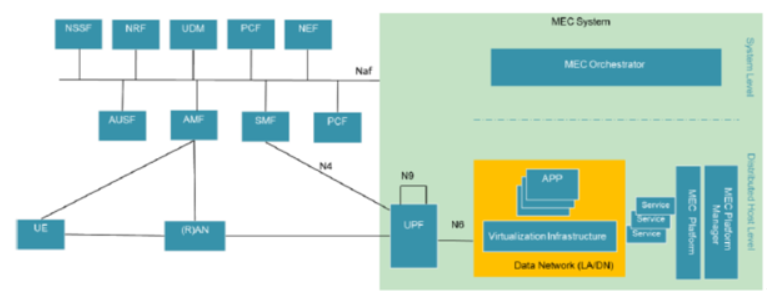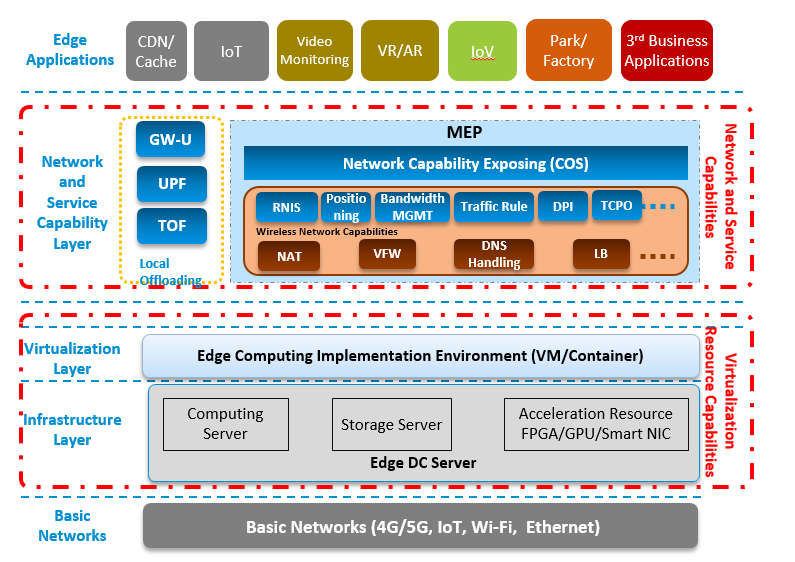MEC (Multi-access Edge Computing), which is an edge cloud platform, provides a new network architecture through the collaboration of the operator network (the data plane function is a key point). It uses the wireless access network to provide IT services and cloud computing functions for the nearest telecom users, thus creating a carrier-class service environment with high performance, low latency and high bandwidth, so that consumers can enjoy high-quality service experience.

Figure 1 Relationship between MEC System and 5G Network
Source: ETSI White Paper No. 28 “MEC in 5G networks”
The following equation can be simply used to describe the relationship:
MEC = Multiple access modes + Traffic offload + Capabilities (resource, network, service)
Multiple access modes: Users can access the same service deployed at the edge of the network and obtain the same user perception no matter whether they access the network through 4G, 5G, or even fixed networks.
Traffic offload: MEC solves the problem of how to offload services to the nearest local network at the network edge, so that the service path delay can be minimized. The solution is implemented through UPF deployment in 5G network.
Capabilities: MEC provides the cloud computing resource capability, wireless network capability and service enablement capability, and facilitates local computing and processing of edge applications.
MEC Capability Platform Frame
MEC deeply integrates traditional cellular telecom networks with Internet services to reduce the end-to-end latency of user service interaction and improve user experience by exploring the inherent capabilities of wireless networks. Considering the complete MEC solution, MEC not only needs the support of communication network capability (CT capability), but also needs the support of cloud computing capability (IT capability), so MEC is the best combination of ICT technology integration.

Figure 2 Basic MEC Architecture of Convergent ICT
The basic MEC architecture can be generally divided into four layers.
The first layer is the infrastructure layer, including various types of servers, such as computing servers (computing capability), storage servers (storage capability), and hardware acceleration cards, meeting multiple requirements such as AI reasoning, graph/image rendering, and high-speed network forwarding.
The second layer is the virtualization layer, which provides virtualization platform resources and management for upper-layer capability services and APPs, including VMs and containers, so that different applications can share the same infrastructure.
The third layer is the network and service capability layer. The network capabilities include traffic offload and basic service capabilities such as NAT, virtual firewall VFW, DNS and service load balancing. In addition, it provides RNISs (Radio Network Information Service), bandwidth management services, service routing rules and wireless indoor positioning services. These services are provided through the network capability exposing framework through the API interface. The edge service capability layer uses a MicroService framework, and can introduce new capabilities, such as AI capability and big data capability, to enrich and improve the MEC capability layer.
The fourth layer is the applications deployed at the edge, such as video surveillance, AR/VR video and campus applications.
Wireless Network Capability
For operators, MEC should consider how to give full play to the advantages of mobile communications networks, and take CT capabilities as the focus to provide a unified MEC platform for ICT integration. MEC provides CT-specific wireless network capabilities, such as:
- Traffic Offload Capability
The local traffic offload capability is the core capability of MEC. In application scenarios such as local computing and enterprise parks, how to flexibly and efficiently perform local traffic offload and nearby access of service data streams is first solved. Depending on different networking conditions, the optional solutions include the TOF+ solution oriented to 4G network (through SGW, deploy data to MEC and enhance LBO (Local breakout) function). The CUPS solution is deployed with C/U separation. GW-C is deployed in the core equipment room, and GW-U is deployed in the edge equipment room to implement local traffic offload through the traffic distribution function of GW-U. The 5G-oriented UPF solution can use LADN (Local Area Data Network), and uplink classifier UL CL (Uplink Classifier) or IPv6-based Multi-homing.
ZTE provides a local MEC offload solution integrating 4G with 5G. On the same platform, the above offload functions are used as service plug-ins on the MEC platform. The flexible plug-in mode supports Traffic Offload in 4G, 5G NSA and 5G SA networking conditions.
- NAT/VFW/DNS/LB
After the service data traffic is distributed and unloaded locally, it is transferred to the MEP platform in tunnel mode. The MEP platform provides NAT (network address translation), VFW (virtual firewall), DNS (domain name service) and LB (load balancing), and distributes the service data traffic from the carrier network to each APP application.
- Wireless Indoor Positioning
By integrating multiple positioning technologies such as indoor base station and Bluetooth, MEC provides the indoor positioning capability with the range of 3-5 meters. In addition, it can implement coordination management through the MEC-based IoT management platform such as geomagnetic fields, fire-fighting nozzles, fire alarms and other wireless sensors. This kind of indoor positioning capability can be exposed to third party applications and the big data platform in the shopping mall through the API mode, to provide users with indoor navigation and intelligent parking service applications, so as to provide location service capability on the basis of the existing communication capability network.
ZTE's QCell equipment based on indoor coverage, together with the MEC location service, has cooperated with such application partners as Innsmap and INNS Big Data for multiple projects with respect to smart shopping center, smart building, and smart park.
- Traffic Rule
The MEC platform needs to provide the service rule management configuration function. Edge applications can dynamically change the local traffic offloading policy through the corresponding service rule configuration interface, so that local services can be flexibly controlled by domain name, IP 5-tuple, user, and base station location.
- DPI/TCP Optimization
This function aims to optimize network performance and improve user QoE. The MEC-based DPI function implements in-depth packet recognition on the MEC platform, and notifies the recognition result to the base stations through the accompanying packet. The base station guarantees differentiated scheduling algorithms for specific service types according to the set policy, thus achieving better service experience.
The MEC-based TCP optimization solution integrates TCP air interface optimization (that is the unique feature of the wireless network) with TCP congestion optimization on the wired side to improve TCP service performance through HTTP fragmentation proxy, TCP transparent proxy, TCP congestion control, and wireless resource scheduling optimization.
The test result of ZTE in the pilot test of China Unicom's existing network in Shenzhen shows that after the MEC-based TCP optimization function is deployed, the typical HTTP and video services can obtain 15% in the uplink and 30% in the downlink.
- RNIS
RNIS (Radio Network Information Service) provides wireless network-related services for MEC applications and the MEC platform, and the information can be used to optimize the existing services. RNIS can provide such information as cell ID, radio channel quality, cell load and throughput. With the introduction of AI and other artificial intelligence analysis and reasoning capabilities, the service QoS can be guaranteed from the user level, flow level to packet level at a finer granularity, and new network capabilities such as location perception and link quality prediction can be provided.
Conclusion
In the 4G era, the smart terminal technology (terminals directly provide computing capabilities) promotes the development of the PC Internet towards mobile Internet networks. In the 5G era, the MEC technology (network edges provide computing capabilities) will promote the integration between cloud computing platforms and mobile networks, bringing a new business ecosystem and new service models.
MEC is both a resource computing platform and a wireless network capability platform. By integrating the mobile access network with Internet services, it can not only improve user experience and save bandwidth resources, but also deploy computing capabilities to network edges to provide third party’s integrated applications, offering imaginary space for service innovation at the mobile edge entrance.
The network connection of the MEC platform is the key, its computing power is the effective assurance, and its network capability and its openness are the driving force. By deploying the MEC platform, the operator can make full use of 5G network advantages, fully explore wireless network capabilities, enable digital transformation in the industry, and provide infinite possibilities for creating more network values in the future.
ZTE supports AI with full-stack IT offering
5GC Green Engine Solution to Enable Green Internet of Everything in the Dual-Carbon Era
5GC Private Network 2.0 Empowerment and Efficiency Improvement Boosts High-Quality Development of the Industry
5G Empowers Intelligent Mining for High-quality Development of Shaanxi Coal Caojiatan Mining
ZTE and China Mobile embrace digitalization for biodiversity conservation in Panda Reserve
Three Aspects Contribute to ZTE’s Remarkable Breakthroughs in Advanced G4X Server
How 5G Private Networks Are Poised to Transform Enterprises Worldwide: All Scenario Private 5G Helps Operators to Realize Private 5G as a Service
ZTE’s commitment to servers generates robust growth of up to 60 times in past 8 years
ZTE eyes top 5 global server market share
Full-Scenario One-Stop 5G Private Network for Vertical Industries

